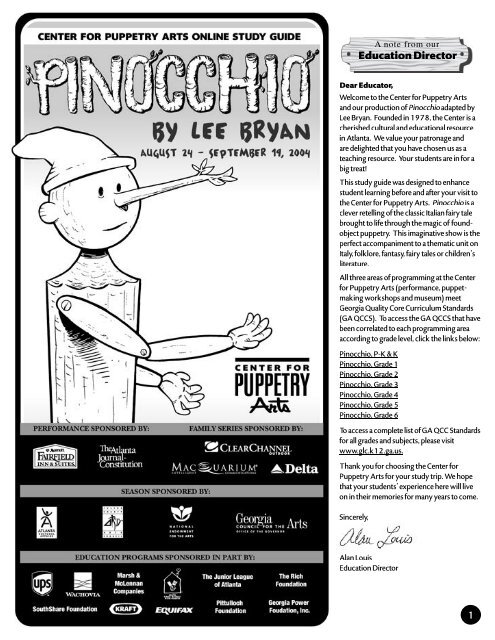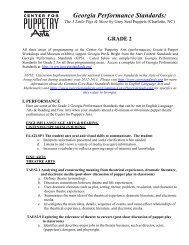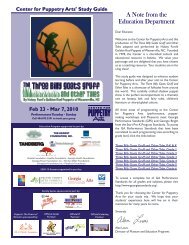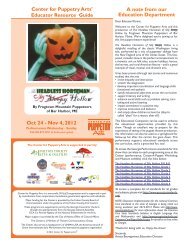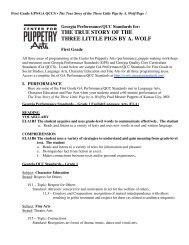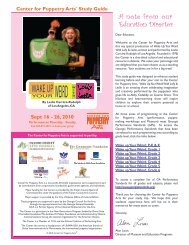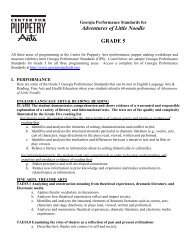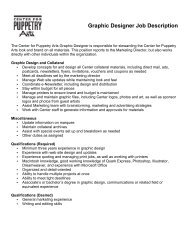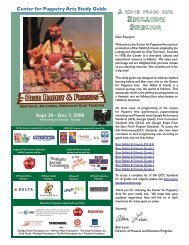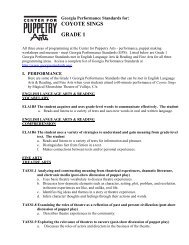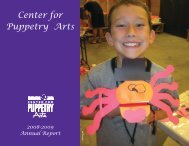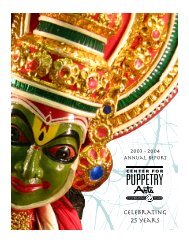Pinocchio - Center for Puppetry Arts
Pinocchio - Center for Puppetry Arts
Pinocchio - Center for Puppetry Arts
Create successful ePaper yourself
Turn your PDF publications into a flip-book with our unique Google optimized e-Paper software.
A note from our<br />
Education Director<br />
Dear Educator,<br />
Welcome to the <strong>Center</strong> <strong>for</strong> <strong>Puppetry</strong> <strong>Arts</strong><br />
and our production of <strong>Pinocchio</strong><br />
adapted by<br />
Lee Bryan. Founded in 1978, the <strong>Center</strong> is a<br />
cherished cultural and educational resource<br />
in Atlanta. We value your patronage and<br />
are delighted that you have chosen us as a<br />
teaching resource. Your students are in <strong>for</strong> a<br />
big treat!<br />
This study guide was designed to enhance<br />
student learning be<strong>for</strong>e and after your visit to<br />
the <strong>Center</strong> <strong>for</strong> <strong>Puppetry</strong> <strong>Arts</strong>. <strong>Pinocchio</strong> is a<br />
clever retelling of the classic Italian fairy tale<br />
brought to life through the magic of foundobject<br />
puppetry. This imaginative show is the<br />
perfect accompaniment to a thematic unit on<br />
Italy, folklore, fantasy, fairy tales or children’s<br />
literature.<br />
All three areas of programming at the <strong>Center</strong><br />
<strong>for</strong> <strong>Puppetry</strong> <strong>Arts</strong> (per<strong>for</strong>mance, puppetmaking<br />
workshops and museum) meet<br />
Georgia Quality Core Curriculum Standards<br />
(GA QCCS). To access the GA QCCS that have<br />
been correlated to each programming area<br />
according to grade level, click the links below:<br />
<strong>Pinocchio</strong>, P-K & K<br />
<strong>Pinocchio</strong>, Grade 1<br />
<strong>Pinocchio</strong>, Grade 2<br />
<strong>Pinocchio</strong>, Grade 3<br />
<strong>Pinocchio</strong>, Grade 4<br />
<strong>Pinocchio</strong>, Grade 5<br />
<strong>Pinocchio</strong>, Grade 6<br />
To access a complete list of GA QCC Standards<br />
<strong>for</strong> all grades and subjects, please visit<br />
www.glc.k12.ga.us.<br />
Thank you <strong>for</strong> choosing the <strong>Center</strong> <strong>for</strong><br />
<strong>Puppetry</strong> <strong>Arts</strong> <strong>for</strong> your study trip. We hope<br />
that your students’ experience here will live<br />
on in their memories <strong>for</strong> many years to come.<br />
Sincerely,<br />
Alan Louis<br />
Education Director<br />
1
about<br />
the artist<br />
Lee Bryan is a nationally<br />
recognized touring puppeteer<br />
who has entertained the<br />
imaginations of audiences across<br />
the U.S. with his unique brand<br />
of curriculum-based “puppet<br />
programs with a punch.” He<br />
received a prestigious Jim Henson<br />
Foundation grant <strong>for</strong> the creation<br />
and development of innovative<br />
works of puppet theater in order<br />
to produce his version of <strong>Pinocchio</strong>. Bryan’s professional f ilm<br />
credits include work with the Muppets® on the feature f ilm,<br />
“The Adventures of Elmo in Grouchland.” Most recently, The<br />
National Academy of Television <strong>Arts</strong> and Sciences honored<br />
him with an Emmy® nomination <strong>for</strong> his work with Public<br />
Broadcasting on the award winning Spanish language series,<br />
¡SALSA! Bryan is a member of The Puppeteers of America and<br />
UNIMA-USA (Union Internationale de la Marionnette), and is<br />
currently serving as President of The Atlanta <strong>Puppetry</strong> Guild.<br />
synopsis<br />
<strong>Pinocchio</strong><br />
begins when a lonely Gepetto (played by Lee Bryan<br />
with a Commedia-del-arte style mask and a thick Italian accent)<br />
makes a puppet to keep him company. He soon discovers that<br />
this is no obedient collection of baskets, old belts and wooden<br />
spoons: the puppet <strong>Pinocchio</strong> has an attitude and is determined<br />
to have his own way. When Gepetto sends <strong>Pinocchio</strong> to school,<br />
the puppet is quickly derailed from his purpose by a roving<br />
puppeteer (Bryan again, this time in Groucho Marx nose and<br />
glasses), setting in motion a grand adventure in which <strong>Pinocchio</strong><br />
encounters a host of colorful characters, both well-intentioned<br />
and treacherous. He meets a conniving, money-grubbing fox<br />
and cat, a lazy boy named Lampwick played by, of course, a<br />
lamp; and the ethereal Blue Fairy who tries to steer the wayward<br />
puppet in the right direction. Meanwhile, Gepetto, distraught by<br />
<strong>Pinocchio</strong>’s disappearance, sets out to f ind his beloved puppet.<br />
He searches far and wide and f inally takes to the sea. As he<br />
sails, there is a terrible storm. Gepetto’s boat capsizes and he is<br />
swallowed by the great dogf ish, or shark. Things seem grim<br />
<strong>for</strong> the toymaker until he is reunited with his little puppet that<br />
rescues Gepetto from the shark and in the end becomes a real<br />
boy.<br />
style of<br />
puppetry<br />
Lee Bryan’s adaptation of <strong>Pinocchio</strong><br />
is per<strong>for</strong>med using a style<br />
known as found-object puppetry. Rather than handcrafting<br />
realistic-looking puppets based on an artist’s sketches,<br />
Bryan used his imagination to construct the characters from<br />
pre-existing things you might f ind around the house, such<br />
as mops, colanders, pots, pans, baskets, sheets, a plunger,<br />
curtains, neckties, hangers, wooden spoons, belts and a coat<br />
rack. The shape, texture and movement of the objects suggest<br />
certain human (and sometimes non-human) attributes of the<br />
characters in the play. Found-object puppets often lack small<br />
details like facial features, requiring audience members to use<br />
their imaginations to f ill-in-the-blanks. After you’ve seen this<br />
show, you won’t look at everyday objects the same way again.<br />
about the<br />
author<br />
Carlo Lorenzini was born in<br />
Florence, Italy in 1826. He spent<br />
most of his career writing <strong>for</strong><br />
adults until he was assigned the<br />
task of writing several translations<br />
of French fairy tales <strong>for</strong> children.<br />
This experience inspired him to<br />
write his own children’s stories. He<br />
published them in a magazine called<br />
Giornale per i bambini, “Magazine <strong>for</strong> Children.” From 1881 to<br />
1883, he published the stories that make up The Adventures<br />
of <strong>Pinocchio</strong>: Story of a Puppet<br />
as separate installments <strong>for</strong> the<br />
magazine. After the last story appeared in 1883, all of the stories<br />
were collected in a book. <strong>Pinocchio</strong> has since been translated<br />
into over 200 languages around the world. It has become one<br />
of the most popular books ever written. Long after the author’s<br />
death in 1890, <strong>Pinocchio</strong>’s story lives on in the <strong>for</strong>m of plays,<br />
operas, ballets, puppet shows and numerous f ilms.<br />
Sometimes when publishing their works, writers choose<br />
a different name <strong>for</strong> themselves, called a pen name. Carlo<br />
Lorenzini, the author of <strong>Pinocchio</strong>, used the pen name Carlo<br />
Collodi. The author chose Collodi because it was the name of his<br />
mother’s birthplace, a small medieval village in Italy near the city<br />
of Florence. In Collodi today, there is a special park with beautiful<br />
gardens and playful sculptures dedicated to everyone’s favorite<br />
little puppet, <strong>Pinocchio</strong>.<br />
2
ibliography<br />
• Collodi, Carlo. <strong>Pinocchio</strong>: The Story of a Puppet. Simply Read Books, 2002.<br />
• Collodi, Carlo. The Adventures of <strong>Pinocchio</strong>: Story of a Puppet/Le Adventure Di <strong>Pinocchio</strong>: Storia Di<br />
Un Burattino. (Bilingual edition) University of Cali<strong>for</strong>nia Press, 1997.<br />
• Collodi, Carlo. The Authentic Story of <strong>Pinocchio</strong> of Tuscany. (The only English edition in print<br />
approved by the Italian National Foundation of Carlo Collodi, Tuscany.) Crystal Publications, 2002.<br />
• Donley, Meryl. World Crafts: Puppets. Franklin Watts Publishers, 1995.<br />
• Hall, Robert A. Italian Stories/Novelle Italiane.<br />
(Bilingual Edition) Dover Publishers, 1990.<br />
• Romano, Lilia E. Italian Fairy Tales (The Hippocrene Library of World Folklore). Hippocrene Books,<br />
1999.<br />
• Lade, Roger. The Most Excellent Book of How to be a Puppeteer. Copper Beach Books, 1996.<br />
• Smith, Lane. <strong>Pinocchio</strong>, the Boy or Incognito in Collodi.<br />
Viking Children’s Books, 2002.<br />
• Vittorini, Domenico. The Thread of Life: Twelve Old Italian Tales.<br />
Running Press, 2003<br />
Internet<br />
Resources<br />
http://www139.pair.com/read/C_Collodi/The_Adventures_of_<strong>Pinocchio</strong>/<br />
Read an online English translation of The Adventures of <strong>Pinocchio</strong><br />
by Carlo Collodi.<br />
http://www.crs4.it/Letteratura/<strong>Pinocchio</strong>/<strong>Pinocchio</strong>.html<br />
Read the original Italian text of The Adventures of <strong>Pinocchio</strong><br />
by Carlo Collodi.<br />
http://www.pinocchio.it<br />
An in<strong>for</strong>mative site from Italy about author Carlo Lorenzini, the town of Collodi, and everybody’s favorite<br />
puppet.<br />
http://www.pinocchios.net/index2.html<br />
Visit the Web site <strong>for</strong> <strong>Pinocchio</strong>’s Marionette Theater in Winter Park, Florida.<br />
http://www.puppetguy.com/<br />
Visit “That Puppet Guy” Lee Bryan’s Web site.<br />
http://www.cyc-net.org/features/ft-pinocchio.html<br />
Read Allan D. Nass’ essay Rediscovering <strong>Pinocchio</strong>, 1997<br />
- a fresh look at the sophisticated lessons wrapped in<br />
this classic children’s tale.<br />
http://www.insecta-inspecta.com/crickets/f ield/index.html<br />
Visit this in<strong>for</strong>mative site about crickets.<br />
http://www.seaworld.org/infobooks/Sharks&Rays/home.html<br />
Visit this site to learn about sharks and their relatives.<br />
http://www.parentsplace.com/expert/family/qas/0,,240123_115141,00.html<br />
Parents and teachers may want to read this article written by a family therapist called, “My Child is Telling Lies!”<br />
1404 Spring Street, NW at 18th • Atlanta, Georgia USA 30309-2820<br />
Ticket Sales: 404.873.3391 • Administrative: 404.873.3089 • www.puppet.org • info@puppet.org<br />
Headquarters of UNIMA-USA • Member of Atlanta Coalition of Per<strong>for</strong>ming <strong>Arts</strong> and Theatre Communications Group<br />
Text by Alan Louis • Design by Wes Duvall • Copyright <strong>Center</strong> <strong>for</strong> <strong>Puppetry</strong> <strong>Arts</strong> Education Dept., July 2004<br />
3
learning<br />
activities<br />
P-K & K: Italy: A Boot-Shaped Country<br />
GA QCC Standards covered: Kindergarten, Social Studies, Geography (Location): 12; (Map and Globe Skills): 14, 15; Core<br />
Skills (Maps and Globes): 36, 38, 39.<br />
Objective: Students will identify Italy as a country in Europe. Students will locate Italy on a globe and then<br />
color a map of Italy to<br />
represent land <strong>for</strong>ms and water. Students will compare and contrast an island to a peninsula.<br />
Materials: Blank maps of Italy, crayons, a globe.<br />
Procedure:<br />
1. Begin by asking students if they have ever had Italian food like pizza, ravioli or spaghetti. (You may want to show pictures<br />
of Italian food to really get their attention.) Ask them if they know what country Italian food comes from. Tell students that<br />
the story of <strong>Pinocchio</strong><br />
also comes from Italy.<br />
2. Show students a globe and remind them that it is a model of the earth. What color are the land <strong>for</strong>ms on the globe? What<br />
color represents water? Show them Italy on the globe. Does the shape of Italy remind them of an article of clothing?<br />
(Boot) Show them how Italy sticks out into the water. This land <strong>for</strong>m is called a peninsula. Ask students how a peninsula is<br />
different from an island.<br />
3. Pass out the blank maps of Italy.<br />
4. Ask students to color the land <strong>for</strong>ms on the map green and the water on the map blue.<br />
5. Ask them to compare and contrast the islands of Sicily and Sardinia to the mainland peninsula of Italy. What makes them<br />
different?<br />
Assessment: Review student maps to see if objectives were met. Post a map of Italy in your classroom. A month after the activity<br />
has been completed, refer to the map and test your students’ retention of lesson objectives. Do they remember the differences<br />
between a peninsula and an island? What puppet show did they see at the <strong>Center</strong> <strong>for</strong> <strong>Puppetry</strong> <strong>Arts</strong> that was based on a story from<br />
Italy?<br />
Use the blank map of<br />
Italy on the next page <strong>for</strong><br />
this exercise!<br />
4
learning<br />
activities<br />
5
learning<br />
activities<br />
1st & 2nd Grade: Divergent Thinking: Found Object Trans<strong>for</strong>mation Game<br />
GA QCC Standards covered: First Grade, Fine <strong>Arts</strong>, Theater <strong>Arts</strong> (Artistic Skills and Knowledge: Creating, Per<strong>for</strong>ming, Producing): 2,<br />
3. Second Grade, Fine <strong>Arts</strong>, Theater <strong>Arts</strong> (Artistic Skills and Knowledge: Creating, Per<strong>for</strong>ming, Producing): 2, 4.<br />
Objective: Students will use their imaginations to reinvent everyday objects as an introduction<br />
to found-object puppetry, anthropomorphism and characterization (divergent thinking).<br />
Materials: Common household items (items must be clean and brand new; a Dollar Store is a good place to<br />
f ind what you need) such as a sponge, a f lyswatter, a hand broom, a dust pan, a mop, a basket, etc.<br />
1. Teacher should f irst read the Gale Encyclopedia of Childhood and Adolescence article on divergent thinking at<br />
http://www.f indarticles.com/g2602/0002/2602000202/p1/article.jhtml.<br />
2. Collect clean, new household items.<br />
3. Arrange students’ chairs in a circle around the teacher’s chair. Explain to students that they will be playing a game with<br />
“found objects.” Tell students that objects are “things.” Although the things they are going to play with were originally<br />
intended <strong>for</strong> a specif ic use, their job is to imagine each thing as something else. You may want to introduce students to the<br />
term anthropomorphism - the act of attributing human <strong>for</strong>ms or qualities to entities which are not human.<br />
4. The teacher should select an object and hold it up <strong>for</strong> the class to see. Teacher should explain that beginning with her/him,<br />
the object will be passed around the circle from person to person. Each person must imagine the object as something other<br />
than what it actually is (<strong>for</strong> instance, a broom can be an airplane, but it cannot be a broom).<br />
5. Repeat this with several objects, varying the direction around the circle from where you begin. (The most obvious ideas will<br />
be used f irst, making it more diff icult <strong>for</strong> the last students that receive the object to come up with something original. To<br />
really challenge students’ imaginations, continue to pass the same object around the circle two or three times.)<br />
Assessment: Ask students to bring in an object from home not yet used in class. Have students share the object and how they<br />
imagine it as something else. Take a picture of each student with her/his object. Create a bulletin board display from the photos.<br />
3rd & 4th Grade: Write Your Own Puppet Adventure Story<br />
GA QCC Standards covered: Third Grade, Written Communication (writing): 35, 36, 37, 38, 39, 41, 42, 43; Social Studies, Core<br />
Social Study Skills (In<strong>for</strong>mation Processing): 32. Fourth Grade, Language <strong>Arts</strong>, Written Communication (Reading): 35, 36, 37, 38,<br />
39, 41, 42, 43; Social Studies, Core Social Study Skills (In<strong>for</strong>mation Processing): 37.<br />
Objective: Students will write their own f ictional stories about the adventures of a puppet using the writing<br />
process (prewriting,<br />
drafting, revising, editing and publishing).<br />
Materials: Chart paper, lined writing paper, pencils (or computers with word processing software and printers if available).<br />
Procedure:<br />
1. After seeing Lee Bryan’s <strong>Pinocchio</strong><br />
at the <strong>Center</strong> <strong>for</strong> <strong>Puppetry</strong> <strong>Arts</strong>, explain to students that they will<br />
be creating their own<br />
stories about a puppet that has an adventure.<br />
2. Prewriting: On chart paper, brainstorm story ideas with your class. What is a puppet? What different kinds of puppets are<br />
there? What sort of problems might certain types of puppets have? (What would a shadow puppet do with no light to cast<br />
a shadow? A hand puppet with no hand inside it?) What type of relationship might a puppet have to a person?<br />
(Creator-creation, boss-employee, owner-pet) What type of adventures might a puppet have?<br />
3. Drafting: Have students use ideas generated in the brainstorming activity to compose the f irst draft of their story.<br />
4. Revising: Have students revise their stories. Is there a clear beginning, middle and end? Does the story make sense? What<br />
could they add to make it better?<br />
5. Editing: Have students edit their stories <strong>for</strong> correct spelling, capitalization and punctuation.<br />
6. Publishing: Students can publish their stories by reading them aloud or in book <strong>for</strong>m. If making a book, add illustrations.<br />
Assessment: Review students’ work to see if objectives were met. Keep writing samples <strong>for</strong> Language <strong>Arts</strong><br />
portfolios.<br />
6
learning<br />
activities<br />
5th & 6th Grade: Understanding Source Material: Disney vs. Collodi<br />
GA QCC Standards covered: Fifth Grade, Language <strong>Arts</strong>, Written Communication (Reading):<br />
16, 19, 20, 23, 24, 30, 31. Sixth Grade, Language <strong>Arts</strong> (Reading): 32, 34, 36, 40, 44, 49.<br />
Objective: Students will compare a popular f ilm version of<br />
<strong>Pinocchio</strong><br />
to the original 1883 text of<br />
<strong>Pinocchio</strong><br />
by Carlo<br />
Collodi (the<br />
source material <strong>for</strong> the f ilm). Students will respond in writing to present their theories on why the f ilm differs so much from the<br />
original text.<br />
Materials: DVD or video tape of Walt Disney’s 1940 f ilm<br />
<strong>Pinocchio</strong>, DVD player or VCR, a class set of <strong>Pinocchio</strong><br />
books –<br />
the original 1883 text by Carlo Collodi in English (or have students read the text online at http://www139.pair.com/read/<br />
C_Collodi/The_Adventures_of_<strong>Pinocchio</strong>/), paper and pencils, and/or computers with word processing software.<br />
Procedure:<br />
1. As a class, watch the 1940 animated Disney f ilm <strong>Pinocchio</strong>.<br />
2. Explain to students that the source material <strong>for</strong> Disney’s f ilm was The Adventures of <strong>Pinocchio</strong> written by Carlo Collodi<br />
in 1883. Have students begin reading Collodi’s original text online or in book <strong>for</strong>m. Ask them to take notes as they read<br />
describing the differences between the f ilm and the source material.<br />
3. Conduct regular class discussions as students complete the chapters. All will agree that the differences between the<br />
original text and Disney’s f ilm interpretation are vast. Generate a list of reasons why the f ilmmakers might not have been<br />
more true to the original story. (It is not unusual <strong>for</strong> contemporary retellings of classic literature to omit certain details. Can<br />
students recall differences between original texts by the Brothers Grimm and contemporary picture book versions of the<br />
same stories such as Hansel and Gretel or Snow White?) Do students feel that the f ilmmakers made the right decisions in<br />
their interpretation of the source material? Are the changes in the f ilm version so dramatic that the integrity of the story is<br />
compromised? What was added? What was omitted? Is the original story inappropriate <strong>for</strong> children today? (Was this true<br />
in 1940?) Is it important <strong>for</strong> f ilm versions of books to be true to the original texts?<br />
4. After they have f inished reading The Adventures of <strong>Pinocchio</strong>, ask students to write an essay about the difference between<br />
the Disney f ilm and the source material, Collodi’s original text. Ask them to speculate about the reasons why Disney’s f ilm<br />
is so different from the original story.<br />
Assessment: Review students’ work to see if objectives were met. Keep writing samples <strong>for</strong> Language <strong>Arts</strong> portfolios.<br />
7
learning<br />
activities<br />
Name___________________________________ Date__________<br />
<strong>Pinocchio</strong> Word Search Puzzle<br />
O T T A G H A E Y P B I Z Q L<br />
X R J L U H X D M E U U I Z I<br />
D T A C B A V X V S K X G V E<br />
E J S U U O P I V E O N M I M<br />
A P I N O C C H I O N R O G A<br />
V B N E L I R B D V A T O D H<br />
V Z O U O O T D O G S L U O O<br />
E F C Y C J C L G T L O O R E<br />
N S H A R K P A T I W L S K E<br />
T F O X O E Z A R N R A A M C<br />
U M D N L Z C G U C Q U N E V<br />
R G E N O D N D U B W Q F O G<br />
A T E K C I R C G I L S Y D A<br />
P F H U X T V B S P P B Z J U<br />
C G R S C G S U M M E C X J I<br />
Search the puzzle <strong>for</strong> the following words in English and Italian. Circle or highlight each word as you<br />
f ind it. Words are hidden vertically, horizontally and backward.<br />
English Italian English Italian English<br />
Italian<br />
cat..................gatto boy.................ragazzo cricket.............grillo<br />
fox..................volpe nose...............naso adventure........avventura<br />
donkey...........asino lie....................bugia shark...............squalo<br />
Bonus word: <strong>Pinocchio</strong> (same in both languages)<br />
8


